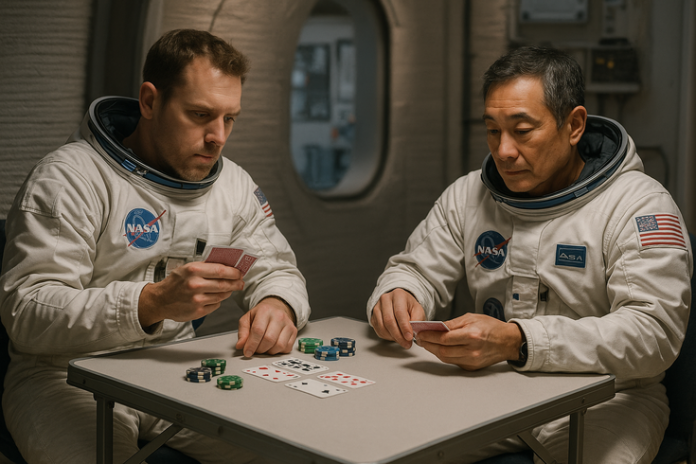When the Space Race Met the Card Table
It’s hard to picture a poker hand floating among rockets, yet the link between the two stretches back to the Cold War. In the late 1950s, engineers at the Jet Propulsion Laboratory would unwind after grueling test drives by shuffling a deck and dealing a round of Texas Hold’em. The informal gatherings were nicknamed “Project Deal,” a nod to the cards that kept morale high while they chased the first American satellite into orbit.
That tradition didn’t die with Sputnik. When Apollo 11 splashed back on Earth, the crew spent two weeks in quarantine – not just sipping coffee, but also swapping stories over a poker table. The ritual of cards became a quiet thread tying together the daring of spaceflight and the camaraderie of a good game.
Life Inside the Mars Dune Alpha
Fast forward to today, and the latest chapter of that story is being written inside Building 220 at Johnson Space Center. The structure, known as the Mars Dune Alpha, is a 1,700‑square‑foot, 3‑D‑printed habitat that mimics the conditions astronauts will face on the Red Planet. Dubbed the CHAPEA (Crew Health and Performance Exploration Analog) mission, the first simulation ran from June 2023 to July 2024, keeping a four‑person crew sealed off for 378 days.
Every detail inside the habitat was engineered for realism: sound‑dampening panels silenced external noise, communication delays replicated the four‑minute lag to Earth, and even the pantry was rationed to mirror Martian supply constraints. The crew’s daily routine was a blend of prescribed exercise, scientific protocols, and strict time‑keeping – a far cry from the free‑wheeling lifestyle most of us enjoy on Earth.
Commander Kelly Haston summed it up best: “You can’t pretend you’re on Mars when you’re standing in a Houston hangar, but you can live the isolation, the limited contact, and the constant need to rely on each other.” Those words capture the psychological pressure cooker the team endured.
The Cards That Kept Them Human
Amid the rigor, a modest pack of cards proved to be a lifeline. NASA’s payload budget is unforgiving; every gram must earn its place. Yet the agency allocated a few ounces for a standard 52‑card deck, recognizing that mental health is as critical as oxygen levels.
What started as a casual pastime quickly morphed into a month‑long Texas Hold’em marathon that stretched over ten months of the analog mission. With no chips on hand, the crew improvised, using colored reagent caps from their science kits as makeshift betting tokens. The caps vanished faster than the crew’s spare water bottles, repurposed for experiments and then reclaimed for the next hand.
Medical Officer Nathan Jones eventually walked away with the most chips – or caps – and claimed the unofficial title of “house champion.” Haston laughed that she was “terrible at poker,” but she added that the game became a crucial social glue. “When you’ve talked about everything you can think of, the cards give you fresh stories, new jokes, and a reason to sit together,” she explained.
Psychologists monitoring the crew noted a measurable dip in stress markers during poker nights. The game forced players to read opponents, manage risk, and make quick decisions under pressure – all skills directly transferable to real‑world space operations where a split‑second judgment could mean the difference between life and death.
The Future of Play Beyond Earth
NASA isn’t the only one seeing the upside. Professional poker player‑turned‑astrophysicist Liv Boeree argues that the strategic depth of poker mirrors the uncertainty of interplanetary travel. “Every hand is a micro‑simulation of risk assessment,” she said. “If you can keep your mind sharp while dealing with unknowns at a table, you’re better prepared for the unknowns of a Martian surface mission.”
Of course, playing a hand with someone back on Earth isn’t exactly feasible when signals take up to 22 minutes to travel between planets. Boeree jokes that interplanetary tournaments would be “the longest‑lasting poker night in history,” but she believes the core lessons – patience, probability, emotional control – remain valuable even when the deck is the only opponent.
The next CHAPEA analog is already in the works, slated to run through October 2026, with a third mission penciled in for the years after that. Each iteration will likely include a fresh deck, perhaps even custom‑designed cards featuring Mars imagery, to keep the tradition alive.
When humanity finally steps foot on the Martian surface, it won’t be surprising to see a small, well‑worn deck tucked into a crewmember’s personal kit alongside food rations and scientific instruments. The cards may not replace life‑support systems, but they could very well become the unsung heroes of morale, decision‑making, and crew cohesion on the longest journey we’ve ever undertaken.

